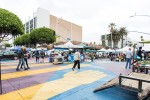Crossing the street is now a work of art in Santa Monica.
Francie Stefan, the mobility manager for the city of Santa Monica, worked with Los Angeles-based urban design firm Here Design Studio, LLC to launch a pilot program in September to paint two crosswalks near the Third Street Promenade. Their goal is to encourage walking and make crosswalks more visible to drivers, increasing pedestrian safety with visually appealing art, said Stefan, a UCLA alumna from the Luskin School of Public Affairs.
The crosswalks are meant to reflect Santa Monica’s welcoming of ideas and signature sunsets, said Amber Hawke, an artist of the project and a co-director of Here Design Studio, LLC.
The first colorful crosswalk, on the intersection of Arizona and Second streets, features silhouettes of hands reaching for one another in front of a blue and purple striped background. Hawke, who also graduated from the School of Public Affairs, said the hands stand for the city’s inclusion and pride.
On the second crosswalk, on Broadway and Ocean avenues, a sun and different shades of orange and yellow reflect the Santa Monica sunset, Stefan said. Since it is a regular crosswalk rather than a four-way diagonal intersection, the painting is smaller than the one on Arizona Street.
[Related: UCLA gallery exposes students to Plastic Jesus’ street art]
The artwork enhances the experience of walking in Santa Monica by adding street paintings that reflect the Santa Monica beach, pier and signature sunsets, Stefan said.
“Walking is an important part of culture,” Stefan said. “People come to Santa Monica just to walk.”
Hawke’s main focus with the project was to help people get around the city even if they don’t have a car, she said. The design firm’s previous projects also centered on this idea, such as adding pedestrian signage near transit stops for increased walker safety.
“People think the car is king in Los Angeles,” she said. “But our mission is about enhancing mobility.”
Stefan said city officials chose the two locations specifically because a lot of people walk there on a daily basis. Officials also wanted include both a regular two-way crosswalk and a diagonal crosswalk in their pilot program, she said.
In about six months, city officials will evaluate the pilot program to see the paint’s durability to determine whether they want to paint other crosswalks, Stefan said.
City officials contacted the design firm to plan the crosswalks over the course of a few months starting in July, Hawke said. The process involved meeting with community members and circulating an online survey among Santa Monica residents, she said. The survey, released in July, asked people what they love the most about Santa Monica and what they wanted to see on the painted on the crosswalks, Hawke said.
“All of these little improvements in Santa Monica make it more of a pleasant experience,” Hawke said. “By creating an element of surprise, it makes it more enjoyable.”
The crosswalks are just one part of Santa Monica’s attempt to make it safer to use modes of transportation other than cars, such as walking and bicycling, Stefan said. With the recent opening of the Expo Line in May, the city worked to widen sidewalks and encourage walking through efforts like the colorful crosswalks, she said.
[Read more: Expo Line 2016 interactive page]
Anastasia Loukaitou-Sideris, the associate dean of the Luskin School of Public Affairs, taught Stefan while she was a student at UCLA. She said a movement started a decade ago in which pedestrians began reclaiming their place in the streets, by calling cities to fix sidewalks and taking parking spaces to create parklets – small extensions of sidewalks that have benches and plants.
The new crosswalks in downtown Santa Monica are an extension of these early pushes for pedestrianism, Loukaitou-Sideris said.
“This is a movement by cities to pay attention to pedestrians,” she said.
Loukaitou-Sideris said she knew Stefan would be successful in contributing to the community through her urban planning.
[Related: prime city guide | Santa Monica]
Stefan hopes the colorful crosswalks have a positive role in making streets more accommodating to different modes of transportation in Santa Monica and that neighboring regions follow their example, she said.
“If you’re 1 year old or 100 years old, everyone walks,” Stefan said. “We want to encourage people to walk.”
